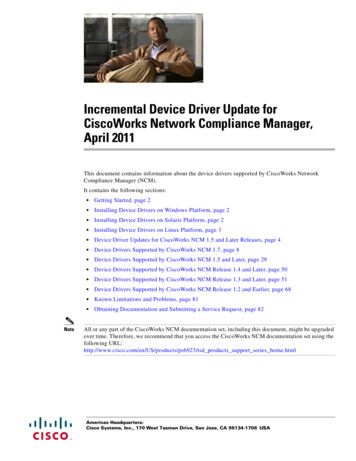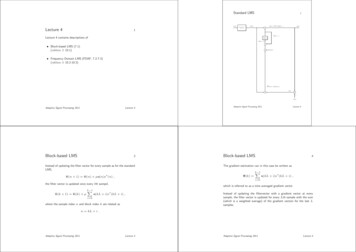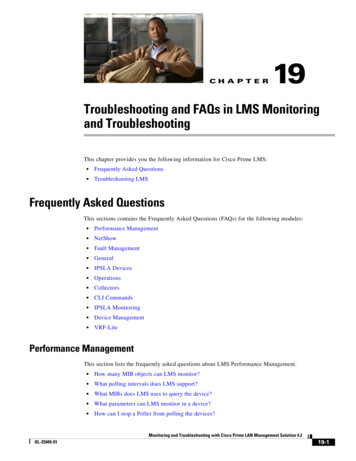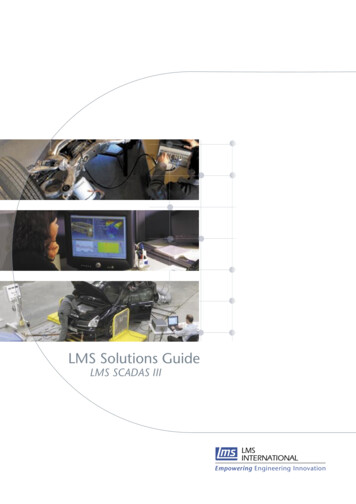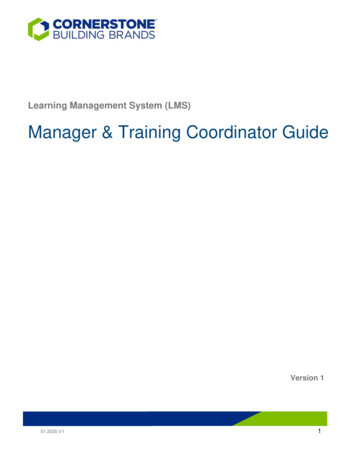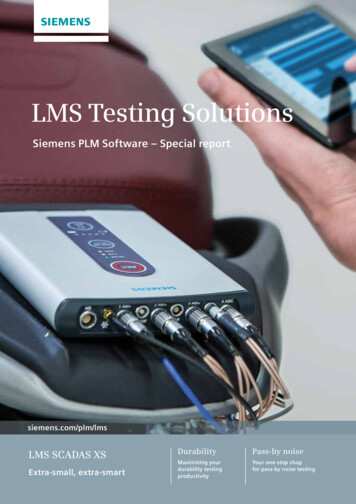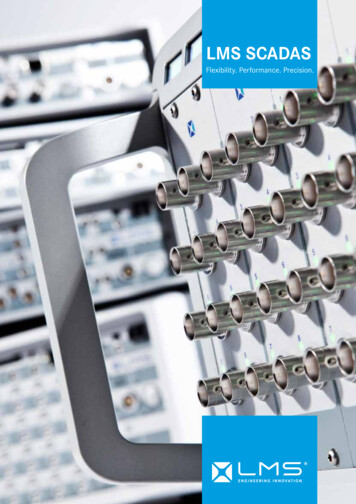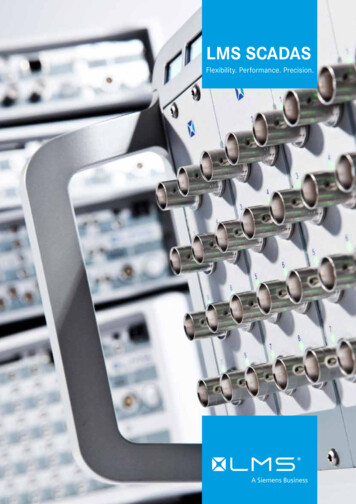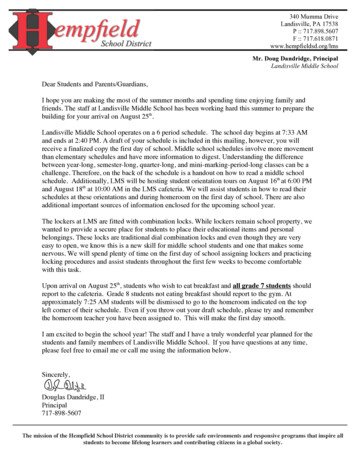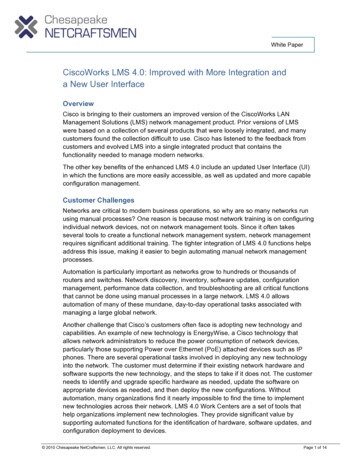
Transcription
White PaperCiscoWorks LMS 4.0: Improved with More Integration anda New User InterfaceOverviewCisco is bringing to their customers an improved version of the CiscoWorks LANManagement Solutions (LMS) network management product. Prior versions of LMSwere based on a collection of several products that were loosely integrated, and manycustomers found the collection difficult to use. Cisco has listened to the feedback fromcustomers and evolved LMS into a single integrated product that contains thefunctionality needed to manage modern networks.The other key benefits of the enhanced LMS 4.0 include an updated User Interface (UI)in which the functions are more easily accessible, as well as updated and more capableconfiguration management.Customer ChallengesNetworks are critical to modern business operations, so why are so many networks runusing manual processes? One reason is because most network training is on configuringindividual network devices, not on network management tools. Since it often takesseveral tools to create a functional network management system, network managementrequires significant additional training. The tighter integration of LMS 4.0 functions helpsaddress this issue, making it easier to begin automating manual network managementprocesses.Automation is particularly important as networks grow to hundreds or thousands ofrouters and switches. Network discovery, inventory, software updates, configurationmanagement, performance data collection, and troubleshooting are all critical functionsthat cannot be done using manual processes in a large network. LMS 4.0 allowsautomation of many of these mundane, day-to-day operational tasks associated withmanaging a large global network.Another challenge that Cisco’s customers often face is adopting new technology andcapabilities. An example of new technology is EnergyWise, a Cisco technology thatallows network administrators to reduce the power consumption of network devices,particularly those supporting Power over Ethernet (PoE) attached devices such as IPphones. There are several operational tasks involved in deploying any new technologyinto the network. The customer must determine if their existing network hardware andsoftware supports the new technology, and the steps to take if it does not. The customerneeds to identify and upgrade specific hardware as needed, update the software onappropriate devices as needed, and then deploy the new configurations. Withoutautomation, many organizations find it nearly impossible to find the time to implementnew technologies across their network. LMS 4.0 Work Centers are a set of tools thathelp organizations implement new technologies. They provide significant value bysupporting automated functions for the identification of hardware, software updates, andconfiguration deployment to devices. 2010 Chesapeake NetCraftsmen, LLC. All rights reserved.Page 1 of 14
White PaperAny given technology can often be deployed in a variety of designs. At NetCraftsmen,we recommend our customers use design templates that can be validated against asbuilt configurations. As a base tool for template development, we like using the CiscoValidated Designs (CVD, formerly known as Solutions Reference Network DesignGuides, or SRNDs). These are designs and templates that Cisco has validated in realnetworks. At NetCraftsmen, we think of them as initial templates against which we buildand then validate customer network designs and configurations. Using the CVDtemplates can save a lot of time in designing a network. They help create networks thatare familiar to the customer and Cisco support engineers and partners, have knownfailure modes, and are therefore easier to troubleshoot so have less down time. LMS 4.0includes the ability to check network configurations against configuration templates, soeven if the CVD is modified slightly for a given customer, it is relatively easy to adjust theconfiguration templates that are used to validate the installed configurations.The result of using a tool such as LMS 4.0 is that the business benefits from less downtime, faster adoption of new technologies, and more consistent and easily maintainednetworks. The only caveat we see is that it is essential that the network staff isadequately trained on the operation of the network management tools. We believe thatthis training is a small price to pay for the benefits.Network Management ArchitectureAt Chesapeake NetCraftsmen, we have developed a network management architecturethat we use to recommend and implement the functions required by an enterprisenetwork management system.Figure 1: Enterprise Network Management Architecture 2010 Chesapeake NetCraftsmen, LLC. All rights reserved.Page 2 of 14
White PaperThe network management architecture includes several key functions:!Event collection, filtering, and forwarding for syslog and SNMP traps. Events are thenotifications that network devices send when something significant happens. Forexample, a Cisco 6500 has approximately ten times as many syslog events as SNMPtrap events, so handling syslog is very important. Events are sent after a problem hasoccurred, so they are the real-time notification that something has changed, eithergood or bad.!Event Processing to de-duplicate, count, correlate, and send notifications of events.An event processing system is needed because the volume of events precludeswatching an event log. The best systems will de-duplicate and count events that arealike and will allow correlation of events with each other, allowing things such as aninterface down event to be automatically cleared by the corresponding interface upevent. A good event processing system provides a good dashboard and notificationmechanism, allowing the network staff to quickly see the active events and get realtime notification of significant events.!Network Change and Configuration Management (NCCM) performs network devicediscovery, inventory, network analysis, and configuration management. A goodnetwork discovery engine that can automatically find network devices, rogue devices,and track users across the network is a critical component of good networkmanagement systems. Once the NMS knows of the network devices, it needs tocollect inventory information, basic operational data, and configurations. The bestproducts perform analysis on the collected data to reduce the workload of the networkstaff. The configuration management function must track and highlight configurationchanges because that’s the most frequent source of network failures.!Performance provides performance dashboards, historical performance data display,and fault identification with notification. Tracking network utilization and performanceis a key function and one that many network managers emphasize. Performancedashboards and reports are key to good functionality in this module.!IP Address Management (IPAM) manages the IP address space and provides DNSand DHCP services. Managing the IP address space and address allocations is a bigtask that is frequently implemented with spreadsheets, with the resulting problems ofmaintaining a single document. Because DNS and DHCP are frequently implementedon separate servers, we often see this function outside the normal NMS platform,either on a dedicated set of appliances, or running on self-maintained servers.We see that LMS 4.0 provides many of the functions identified in our enterprise networkmanagement architecture. LMS 4.0 performs event collection, network discovery,inventory, network analysis, network configuration archive, software imagemanagement, performance data collection, fault identification, notification, and providescustomizable dashboards. 2010 Chesapeake NetCraftsmen, LLC. All rights reserved.Page 3 of 14
White PaperUser InterfaceThe revamped user interface (UI) is more functional and removes the barriers tooperation that made prior versions of LMS more difficult to learn and use. One exampleof the UI improvement is that commonly used functions can be added to a “My Home”page for rapid access. Another UI enhancement is that custom “portlets” can be createdto add any web content to any page, such as showing a weather site along side thepage that displays network events, so that you can watch a storm travel across a regionand track network outages as the storm moves.Device support continues to be impressive, with 600 to 800 known devices, dependingon the LMS function being used. Although you should not have that many differentdevice types in your network, LMS 4.0 should know about it if you do. For example, thenew Nexus products are supported in LMS 4.0, except by the LMS User Trackingfunction. [Note: some of the Nexus performance data is not instrumented so LMS cannotaccess it – this issue is not an LMS problem, and it is being addressed.]Network Change and Configuration ManagementWe believe that configuration management is the most critical function of a networkmanagement system, because of the large percentage of network failures that are dueto configuration errors. Industry studies indicate that forty percent or more of networkoutages are due to configuration mistakes, so configuration management tools can beextremely useful for making networks more stable.(See /1025wan1.html)While a configuration management system does not prevent errors, it allows the networkstaff to validate planned changes against a design template, to manage and automatethe process of rolling out changes, and to perform rapid rollback if a failure occurs.Configuration DashboardThe LMS Configuration Dashboard, shown in the next figure, is a fully customizabledisplay of several key functions regarding the configuration of network devices. Thedashboard elements, called portlets, can be moved, added, or deleted to prominentlyshow important information. 2010 Chesapeake NetCraftsmen, LLC. All rights reserved.Page 4 of 14
White PaperFigure 2: LMS Configuration DashboardLMS automatically performs analysis of the collected data, as evidenced in theDiscrepancies and the Best Practices Deviations functions. The analysis rules for thesesections are currently predefined. We hope the analysis rule API will be published in thenear future to allow LMS customers to customize the built-in rules as well as design theirown, which we believe will significantly increase the utility of LMS.The Software Summary function is useful for tracking software versions deployed on thenetwork. A small improvement would be to include the device types for each OS versionand provide a way to sort by either device type or software version.The Device Change Audit and the Job Information Status portlets identify who performedwhat operations on specific devices or groups of devices. Since configuration changesare the most common source of network problems, examining the Device Change Auditfunction for modifications made at the time that a problem started can help reduce thetime to diagnose a problem.Device GroupingConfiguration and data access in LMS is performed by selecting either individual devicesor groups of devices. Device groups typically correspond to logical operating groupswithin the network, taking into account the function of devices, such as core, distribution, 2010 Chesapeake NetCraftsmen, LLC. All rights reserved.Page 5 of 14
White Paperand access layers, or the location of devices, such as DataCenter1. A variety of criteriacan be used to create a device group, including device names, IP addresses, or whetherthe devices support a specific technology, such as EnergyWise or Smart Ports. Devicescan belong to multiple device groups, which increases efficiency for managing deviceconfigurations and monitoring performance.Configuration ArchiveLMS can archive device configurations, providing a safety net for when a devicecompletely dies or when a major configuration mistake is made and you need to go backto the prior version. The configuration archive shadow directory is an image of the mostrecent configurations gathered by the configuration archive. We recommend enablingthe shadow directory option under the Archive Settings of Archive Management underConfiguration Management, storing the configurations in this secondary directory, andmapping that directory to an external file system on another server. With this practice,even if the LMS server is unavailable, you will have a backup of all the deviceconfigurations. A useful archive search capability exists for performing configurationsearches, but we also like to use Unix tools such as grep, sort, uniq, and wc to searchthe configurations in the shadow directory.Figure 3: LMS Archive Summary ReportWe did encounter a minor problem with the Search Archive function; our MacBook Prorunning Firefox is not a supported platform and the menu did not work correctly.Switching to Internet Explorer or Firefox on a Windows VM solved the problem. We hopethat additional standard business platforms will be supported in future LMS releases.Configuration ComplianceThe function that probably provides the greatest benefit after archiving configurations isthe ability to check them against network policies. A typical policy definition starts withwritten requirements, followed by a configuration template that can be used for deployingnew devices or that can be used to validate existing device configurations forcompliance with the policy. For example, a policy might reflect the desired TACACS Authentication, Authorization, and Accounting (AAA) configuration in Cisco networkequipment. The process is shown in the following figure. 2010 Chesapeake NetCraftsmen, LLC. All rights reserved.Page 6 of 14
White PaperFigure 4: Typical Configuration Compliance ProcessThe Configuration Compliance Template allowed us to configure a policy:Figure 5: Creating a Policy Using the Configuration Compliance TemplateThe LMS compliance policy definition is quite flexible. It can depend on otherconfiguration blocks, it can require commands within a sub-mode, and it can require thatthe commands appear in a specific order. Policy templates are built using regularexpression syntax, which is a powerful pattern matching mechanism, thus the seeminglystrange syntax in the example above. Our test checked the logging configuration of thelab devices. Of course, there were initially many exceptions when we ran the policy:Figure 6: Summary of Initially Non-Compliant DevicesDeploying configuration changes to remediate the exceptions took a number of steps,but was not difficult and it worked quickly. The job monitoring system clearly showed 2010 Chesapeake NetCraftsmen, LLC. All rights reserved.Page 7 of 14
White Paperdevices being remediated, and the resulting compliance checks listed the correctnumber of devices that complied with the policy.Figure 7: Baseline Jobs from the Job Monitoring SystemThere is a file import function to read configuration commands from a file for thosechanges that require per-device parameters, such as IP addresses or device names.Configuration Management SummaryThe configuration archiving and management functionality is useful, allowing us to buildpolicies to check configuration consistency and to correct the configurations where theydid not match the policy template. The released product will include videos that augmentthe written documentation to help new users get started and be successful. Like anygood network management system that has a lot of power, it will require dedicated timeto learn it and be productive.Work Centers to Simplify DeploymentsA Work Center is a set of functions that automate the lifecycle management of deployingand managing a particular technology. The lifecycle begins with assessing whether yournetwork can support the new technologies, making it easier to know when and whereyou can deploy these new technologies. In addition, LMS 4.0 can help facilitate thedeployment of the IOS software versions and configurations that are required for thesupported technologies. For example, the Work Center readiness assessment summaryfor EnergyWise, shown in the following diagram, shows the devices that support it, donot support it, and why they do not support it (software or hardware incapable). Manuallyperforming a readiness assessment in a large network would be time consuming andwould likely never be finished. LMS automates the assessment, making this informationreadily accessible. 2010 Chesapeake NetCraftsmen, LLC. All rights reserved.Page 8 of 14
White PaperFigure 8: Work Center Readiness Assessment Summary for EnergyWisePerformance and MonitoringAs with most network management products, there are dashboard elements formonitoring faults, performance, and events. Faults are typically due to interface ordevice failures and appear in a dedicated window in the Monitoring dashboard. In thepicture below, a set of operationally down interfaces are identified. Any router interfaceor link between network infrastructure devices that is in up/down state should beinvestigated, particularly in highly redundant networks. This practice implies that thenetwork administrators need to shutdown any links that are not used to aid in theidentification of redundant link failures. (Setting the interface description to ‘unused’ alsohelps.)Figure 9: High Severity Faults from the Monitoring DashboardIn addition to the specific faults shown above, LMS includes an events summary thatshows exceptions, sorted by severity (see the following diagram). The summary includesevents such as devices that are no longer responding, perhaps because they areunreachable or because they have crashed. Abnormal events are also logged, such aspower supply failures and high temperature (StateNotNormal) and backup or dialinterfaces that are up for long times (ExceededMaximumUptime). The No. of Devicescolumn contains links to view the devices with each fault. 2010 Chesapeake NetCraftsmen, LLC. All rights reserved.Page 9 of 14
White PaperFigure 10: LMS Fault Events SummaryAfter fault and event handling, performance information is probably the most requestedcapability in a network management system. (Configuration management is the nextmost frequently requested capability, due to the number of network outages that resultfrom lack of configuration management, but most managers focus on performancebefore configuration management.) The LMS monitoring dashboard includes thestandard displays of device CPU and memory utilization.LMS also has interface reporting that includes metrics such as utilization, errors, anddiscards, shown in the following diagrams:Figure 11: LMS Interface Reporting for Utilization and Errors 2010 Chesapeake NetCraftsmen, LLC. All rights reserved.Page 10 of 14
White PaperFigure 12: LMS Interface Reporting for DiscardsTopologyTopology diagrams are indispensible when troubleshooting, and LMS provides atopology display and editor. It relies on the CDP and other data collected during itsnormal polling process to identify the interconnections between devices. Hovering thecursor over a device or a link shows detailed information about that element. We prefertopology displays that include logical and physical information, such as IP addresses,VLAN names/numbers, and interface identifiers, but that would make the diagramdifficult to read. The topology display uses a java web-start application to provide basicediting and layout capability. By adjusting the topology map, we were able to take atopology diagram that was initially unreadable and easily tweak it into a drawing thatshows the hierarchical connectivity that exists.Figure 13: Example LMS Topology Map 2010 Chesapeake NetCraftsmen, LLC. All rights reserved.Page 11 of 14
White PaperPublished Database SchemaThe LMS 4.0 database schema is published, and APIs for various methods of databaseaccess are provided. (Note that LMS 3.2 also published its schema.) This is a hugebenefit because it gives the network staff the ability to perform data searching andqueries that would have previously not been possible. There are also per-device userdefined fields that can contain additional data about the device, such as its specificlocation. For example, in other products we have seen custom database fields used tostore latitude and longitude, which are then used with Google Maps or Google Earth tocreate a display of device locations. Other organizations use these fields to storemaintenance contract information or lease renewal dates, keeping the data with thedevice’s management information. 2010 Chesapeake NetCraftsmen, LLC. All rights reserved.Page 12 of 14
White PaperSummaryKey Benefits and StrengthsThe updated UI is more web-friendly. The different modules that made up prior versionsof LMS have been merged together in 4.0, making it easier to use. Data no longer needsto be imported and exported between modules. Portlets allow customization of individualpages to match an organization’s monitoring requirements. Configuration managementis more advanced, with configuration policy compliance, configuration update, andchange management functions. Support for deploying new technologies such asEnergyWise and Auto Smart Ports have been enhanced. Event processing helps reducethe number of events that must be individually handled, and performance managementstill provides visibility into network health. Access to the database schema and perdevice custom data fields allows network managers and developers to add newfunctionality that was previously impossible.Areas for ImprovementOf course, LMS 4.0 is not perfect. The top enhancements we would like to see include:!Optimize workflows by grouping of functions to make it easy to accomplish commontasks. For example, the information page about a device contains a section labeled“Configuration,” which surprisingly does not have a link to the configuration archive forthat device. Since all the configuration data is available in LMS, this enhancementcould improve the efficiency of the UI.!Add de-duplication and correlation to event management, as is found in other eventmanagement products.!Significantly improve the written documentation, focusing on network managementtasks instead of the emphasis on what each button and dialog box does. Fortunately,there is good online help and short videos on how to accomplish tasks. Until you getaccustomed to the menu layout, you will likely spend some time looking for keyfunctions. This is where My Menu will be useful – you can put your frequently usedfunctions in a private or public menu.!Improve scalability and performance by optimizing the data collection engine. Thisenhancement will scale LMS to support larger networks and provide better overallperformance when LMS is running in smaller networks.!Support the ability to save/load files from the system on which the web browser isrunning and not require access to the LMS server file system. This would optimizethe operations that save or load files from the LMS server’s file system and requireLMS users to have access to the file system.Overall Thoughts on LMS 4.0LMS 4.0 is a significant improvement over prior versions of LMS. The integration of thedifferent tools into one product that uses a common underlying database provides amuch-needed improvement in the usability of the system. Importing data between the 2010 Chesapeake NetCraftsmen, LLC. All rights reserved.Page 13 of 14
White Paperinternal components is no longer needed, making the network administrators moreproductive.The configuration management functionality is exactly what is needed. It has the abilityto verify that configurations match network and corporate policies, including the oftenoverlooked ability to check that the configurations do not include undesirable commands.About Chesapeake NetCraftsmenChesapeake NetCraftsmen, LLC is an advanced network consulting firm that specializesin high-profile and challenging network consulting jobs. A third of the company areCCIEs across the spectrum of specializations. NetCraftsmen is a Premier Cisco Partner,with a large number of Cisco specializations.Terry Slattery is a Principal Consultant at Chesapeake NetCraftsmen. He previouslyfounded Netcordia and Chesapeake Computer Consultants, invented NetMRI, a networkmanagement appliance, and the v-Lab hands-on training system. Terry co-authored thesuccessful McGraw-Hill text Advanced IP Routing in Cisco Networks, and is the secondCisco Certified Internetwork Expert (CCIE #1026) awarded. He focuses on route/switchand network management technologies.Carole Warner Reece is a Senior Consultant at Chesapeake NetCraftsmen. She iscertified by Cisco as CCIE #5168 and also a certified instructor (CCSI #31564). Three ofher current interests are course development, network design and operations, andexploring data center solutions for our customers.Chesapeake NetCraftsmen, LLC.1290 Bay Dale Drive, Suite #312Arnold, MD 210121-888-804-1717www.NetCraftsmen.netCopyright 2010 Chesapeake NetCraftsmen, LLC.All Rights Reserved 2010 Chesapeake NetCraftsmen, LLC. All rights reserved.Page 14 of 14
on the LMS function being used. Although you should not have that many different device types in your network, LMS 4.0 should know about it if you do. For example, the new Nexus products are supported in LMS 4.0, except by the LMS User Tracking function. [Note: some of the Nexus performance data is not instrumented so LMS cannot
